Contents:
a) Major rock types in the valley
b) Water-fluxed melting: no peritectic minerals
c) Bt-dehydration melting
d) Bt-dehydration leucosomes overprinted by Tml-Ms-Bt-Gnt
(water-fluxed) leucosomes
e) Early Bt-leucomes related to water-fluxed anatexis overprinted by
Tml-Ms-Bt-Gnt (water-fluxed) leucosomes
f) Migration of Tml-Ms-Bt-Gnt leucogranite
Reru valley shows rocks with two phases of melting. In parts of the
valley the first phase of anatexis is associated with biotite
dehydration melting. In other parts, with water-fluxing melting giving
rise to a Bt-leucosome in granitic rocks lacking obvious peritectic
minerals. The two are mutually exclusive. This first phase of
water-fluxed anatexis is syn-kinematic.
These two events are followed by a widespread second anatectic phase
characterized by B-rich water influx producing Tml-Ms-Bt-Gt
leucogranites. This is syn- to post-kynematic.
a) Major rock types in the valley Phase 1 dehydration followed by Phase
2 B-rich water-fluxed melting

Figure 1. East side of the Reru valley. A thick and continuous
layer-parallel leucogranite sill >9 km long (field of view 6km
horizontal length) embedded in migmatites with numerous sills and
dykes. Immediatelly above
the sill,sills and dykes are relatively rare and increase in number
away from the large sill further up the wall. This suggests that the
sill may have provided a sink for surrounding magma. |
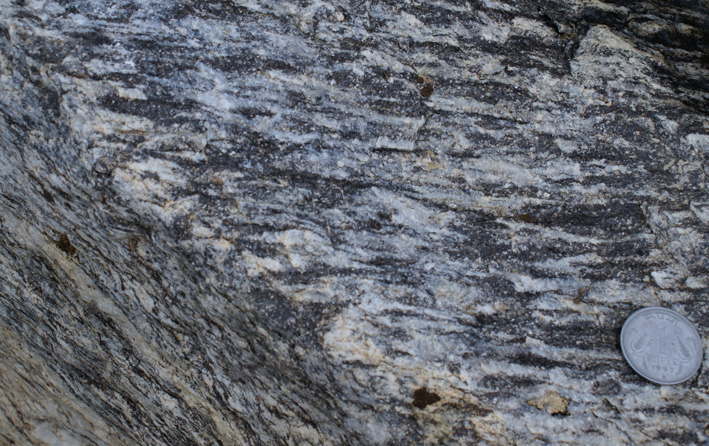
|
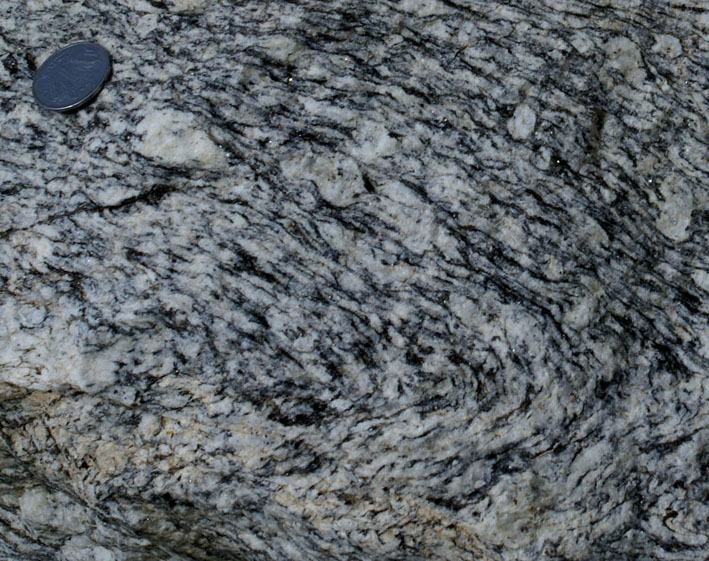
|
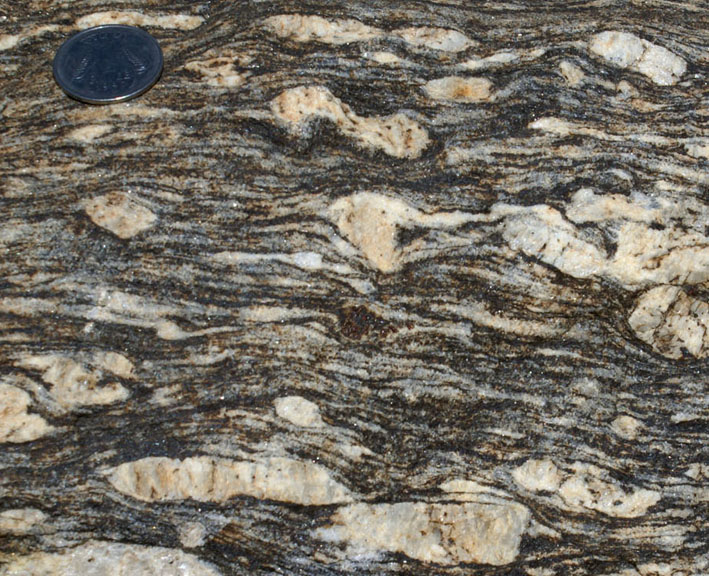
|
| Figure
2a) Two sides of
typical Ms-Bt mylonitic granite
showing intense lineation. |
Figure
2b) Folded coarse
gneiss |
Figure 2c)
Coarse-grained mylonite with K-feldspar
porphyroblasts whose protolith was a porphyritic granite . |
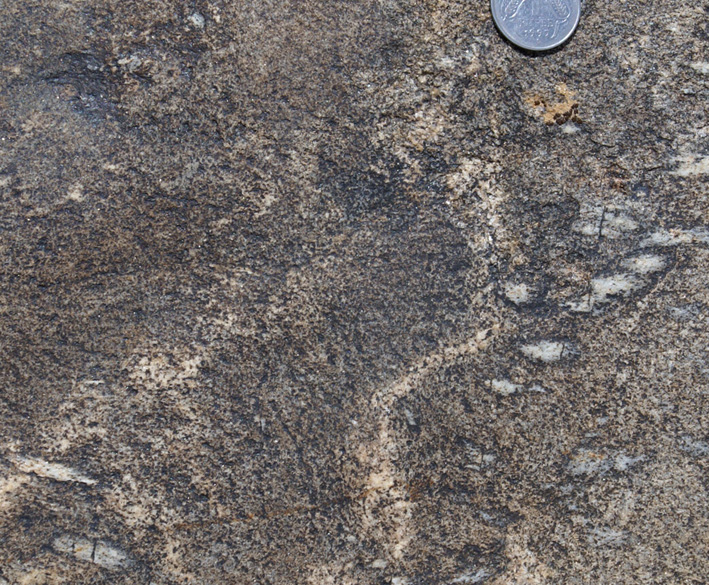
|
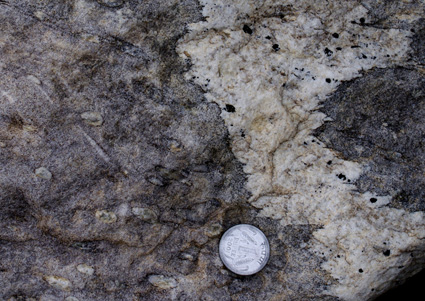
|
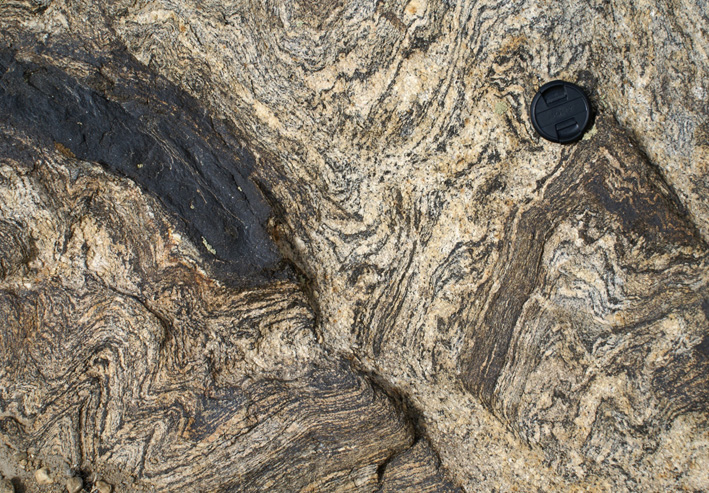
|
| Figure
2d) Sillimanite-biotite
schist with leucosome having diffuse
boundaries suggesting in situ origin. Lack of spatial relationship with
sillimanite suggest that
melting is unrelated to the presence of sillimanite. |
Figure
2e) Folded
sillimanite-biotite schist intruded by tourmaline
leucogranite with irregular boundaries and narrow melanosome rim in
places.
Rock face close to parallel with foliation. The leucogranite is
unrelated to sillimanite grains (left of coin). |
Figure
2f) Folded biotite-rich diatexite with refractory layers. |
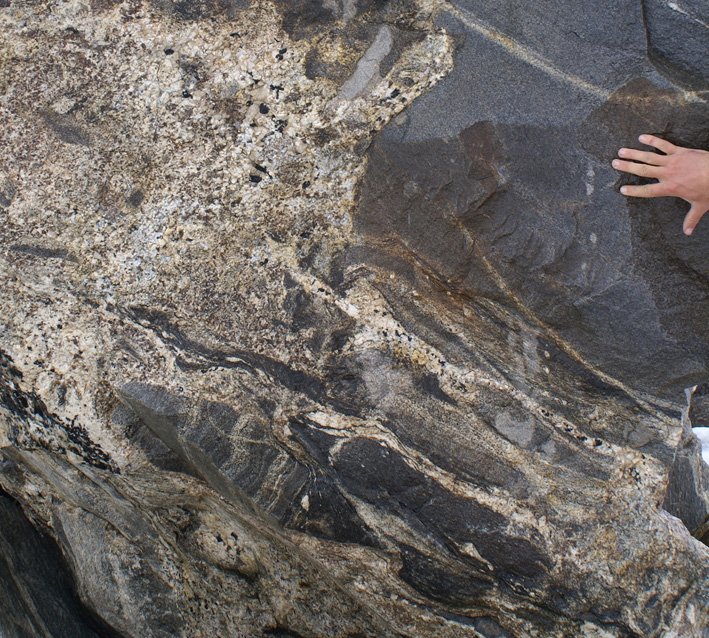
|
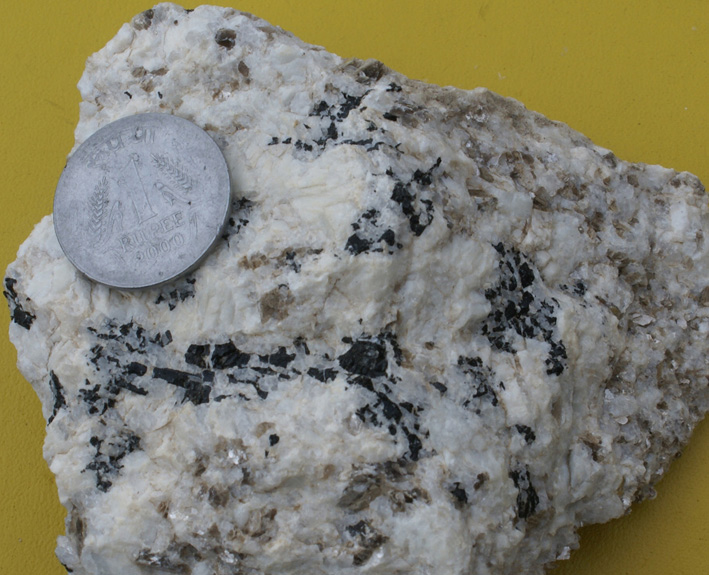
|
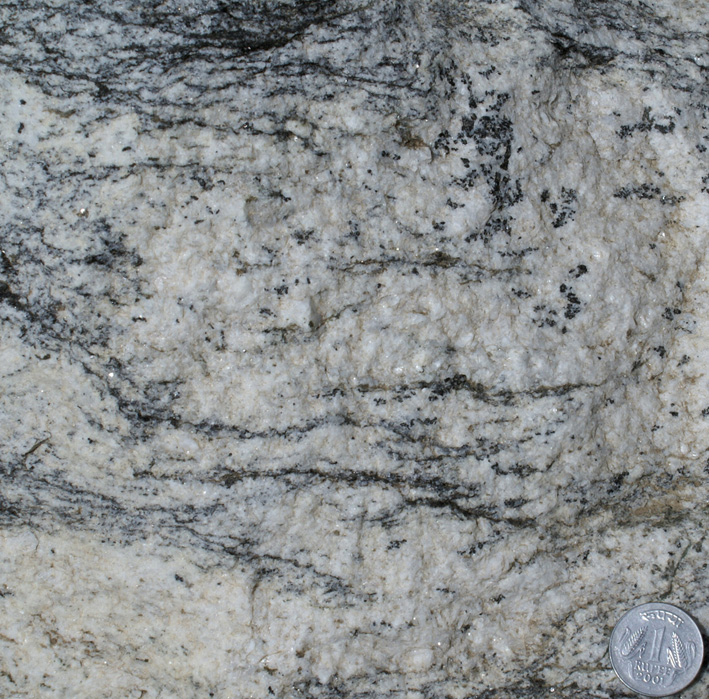
|
| Figure
2g) Tml-leucogranite diatexite. |
Figure
2h) Tml-Ms pegmatite resulting from melting. |
Figure
2i) Banded tourmaline leucogranite. |
b) Water-fluxed melting: no peritectic minerals such as garnet or
sillimanite, passive biotite, voluminous leucosomes. Two main types:
an early event characterized by Bt-bearing leucosomes (figures 3a-c), a
later event characterized by Tml-Ms-Gnt-Bt leucosomes (figures 3d-f).
In this subsection, only one anatectic event is obvious. In section d)
and e) Iexplore overpriting relationships.
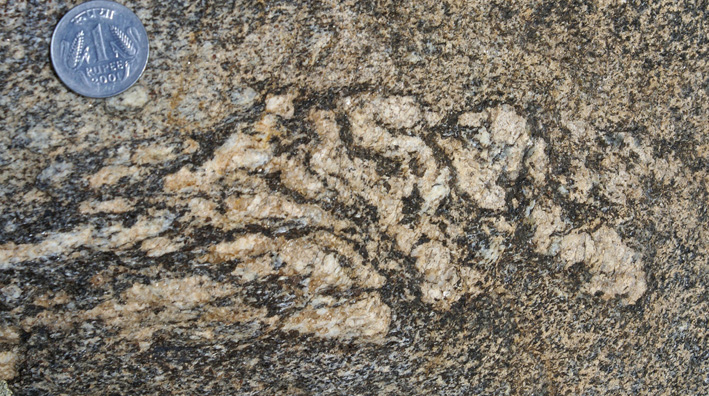
|
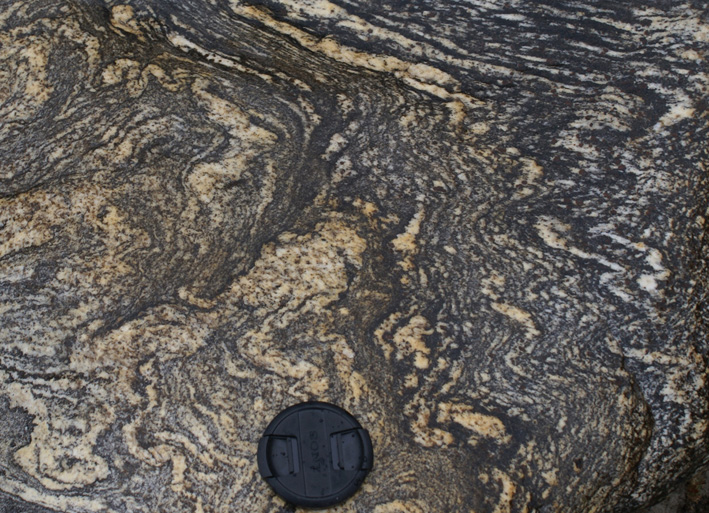
|
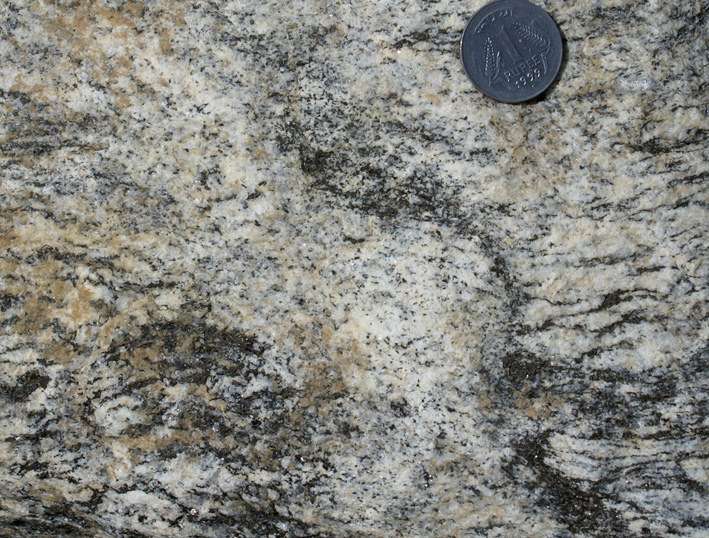
|
| Figure
3a) Leucosome surrounded by a narrow melanosome rim indicative of in
situ derivation, in biotite granite. The leucosome is ptygmatically
folded and streteched in the third dimension (below and to the left of
the coin in this curved block) suggesting a constrictional environment
at high temperature (possibly during melting). |
Figure
3b) Migmatite with ~40% leucosomes, lacking anhydrous peritectic minerals, and
strongly folded and stretched in the thrid dimension on the top part of
the photo (curved block). |
Figure
3c) Leucosome linked to layer parallel leucosome and dragging
refractory biotite grains that accumulate irregularly at the side of
the cross cuttting leucosome. |
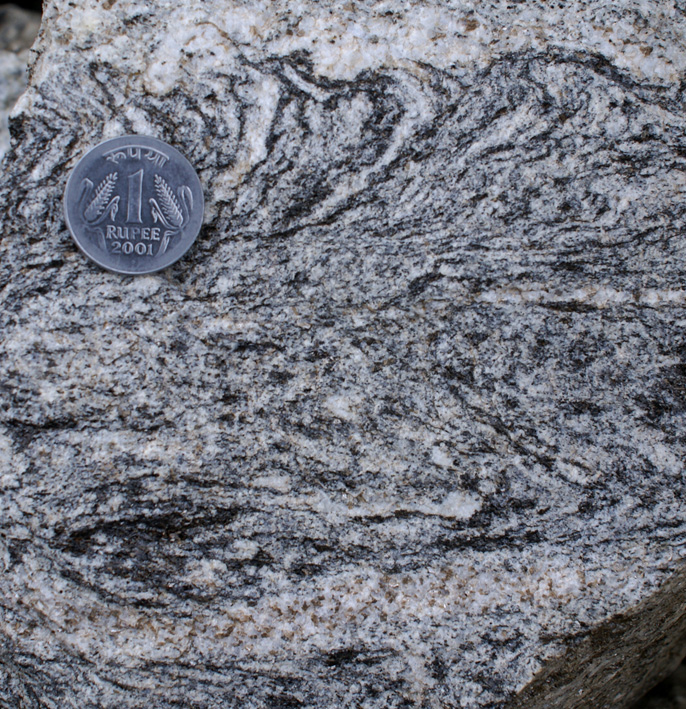
|
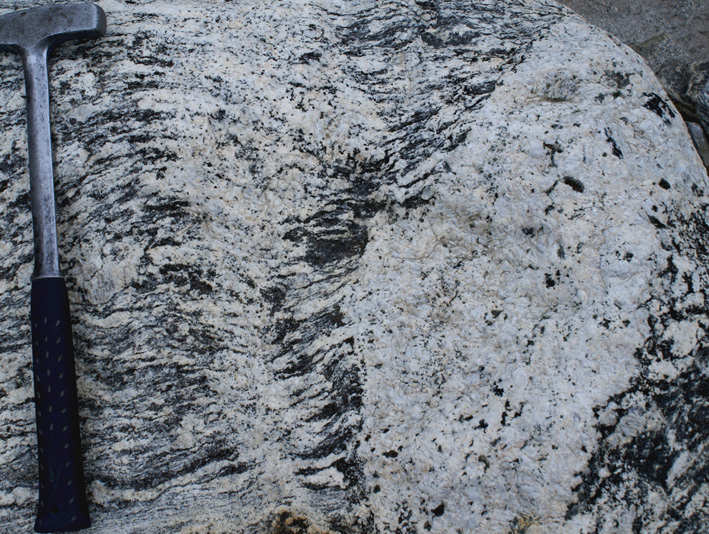
|
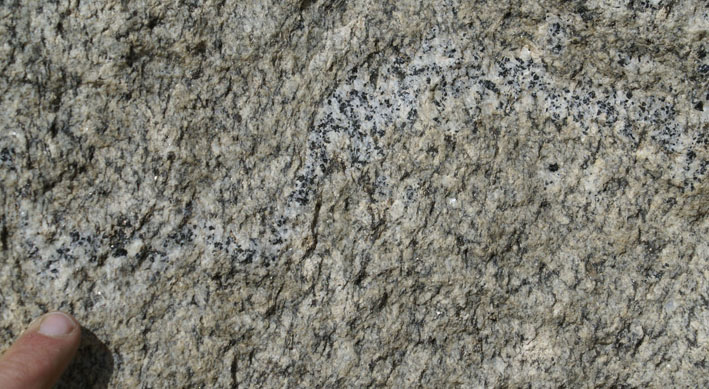
|
| Figure
3d) Axial planar muscovite-bearing leucosomes linked with leucosomes in
the intervening folds, indicative of syn-kinematic melting. |
Figure
3e) Two cross-cutting tourmaline-bearing leucosomes in granitic
migmatite. The one on the left shows intricate relationships with
smaller, foliation parallel leucoscomes in the surrounding rock
suggesting mainly in situ generation, whereas the one on the right has
planar margins with local interaction with surrounding leucosomes,
suggesting mainly intrusive nature. The
large volume of leucosomes and the lack of sillimanite, garnet or any
other obvious peritectic mineral suggests water-fluxed melting. |
Figure
3f) Tortuous white vein with black tourmaline in Bt-leucogranite with a
pre-existing foliation. In this same rock there are equigranular,
centimetric patches of unfoliated tml-leucogranite suggesting in situ
derivation. |
c) Bt-dehydration melting
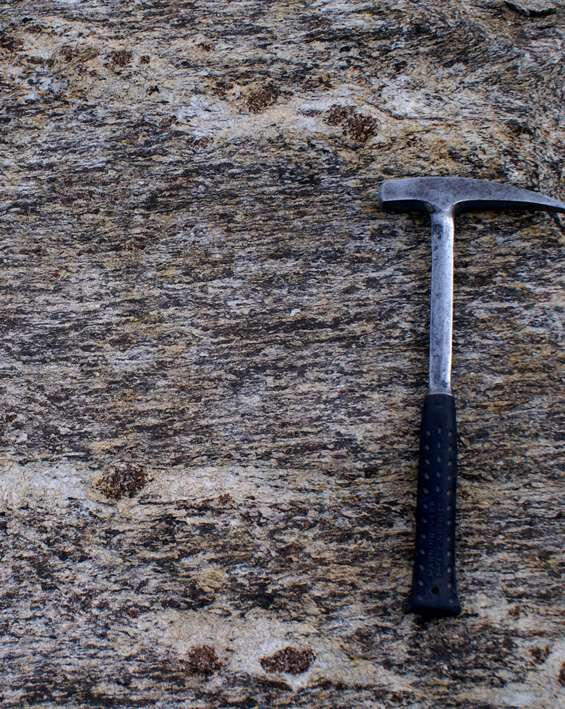
|
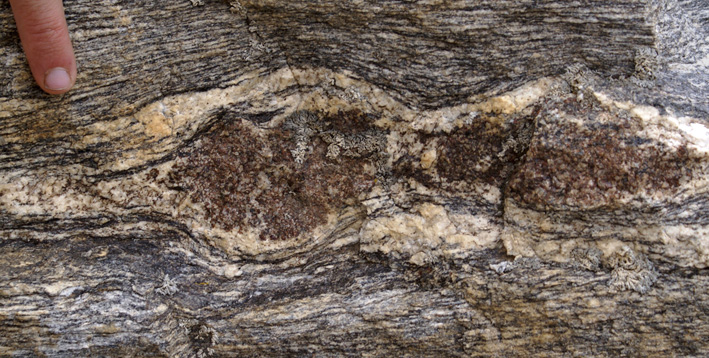
|
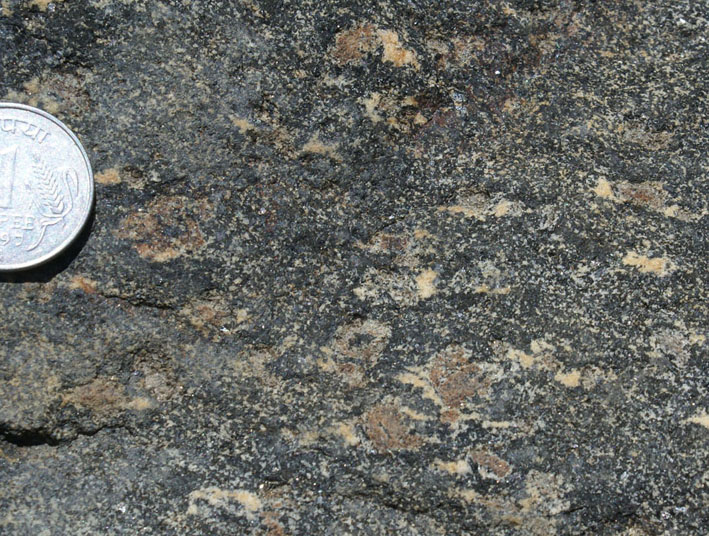
|
| Figure
4a) Leucosome including large garnets in Bt-granite. Plane in rock
nearly parallel to foliation, enhancing the size of features. |
Figure
4b) Large garnet grains surrounded by leucosomes. The relatively small
volume of leucosome compared to the garnet, and the absence of garnet
retrogression to biotite, suggest loss of melt from the system. |
Figure
4c) Small garnets surrounded by narrow leucosomes, remnants of magma. |
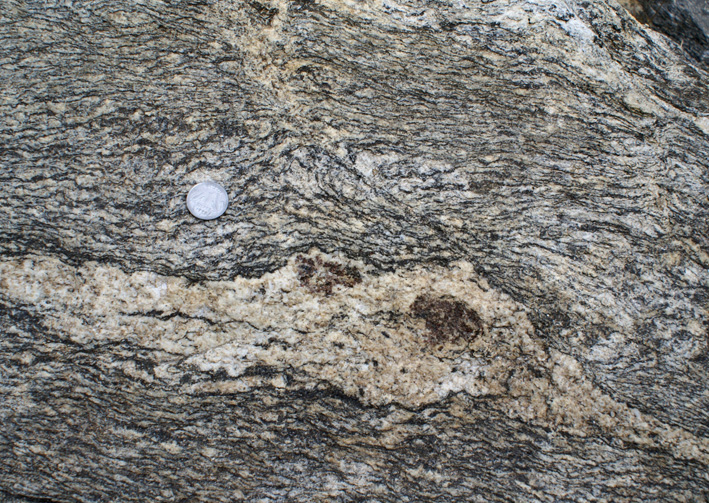
|
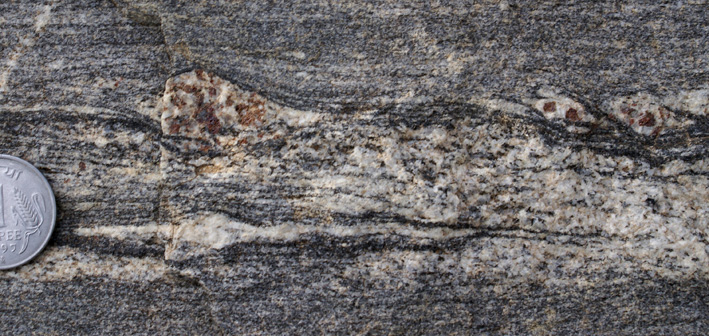
|
| Figure
5a) Garnet in leucosome parallel to the main foliation localizing
strain during a late (or continued) deformation event. |
Figure
5b) Garnet in leucosome forming apaprent sinistral fish indicative of
pre- or syn-kinematic partial melting through Bt-dehydration. |
d) Bt-dehydration leucosomes overprinted by Tml-Ms-Bt-Gnt
(water-fluxed) leucosomes
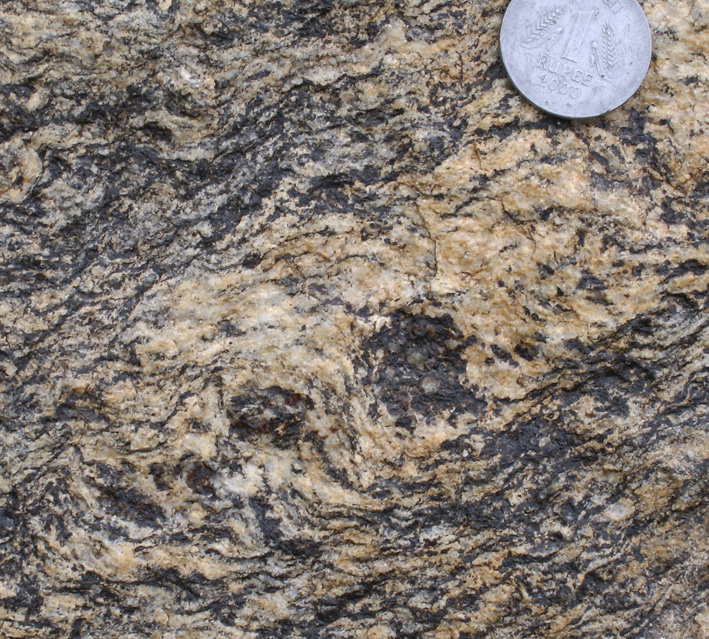
|
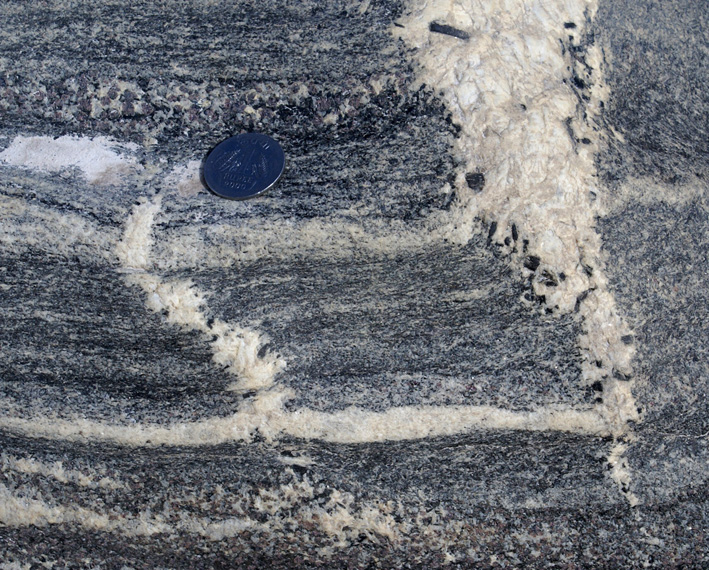
|
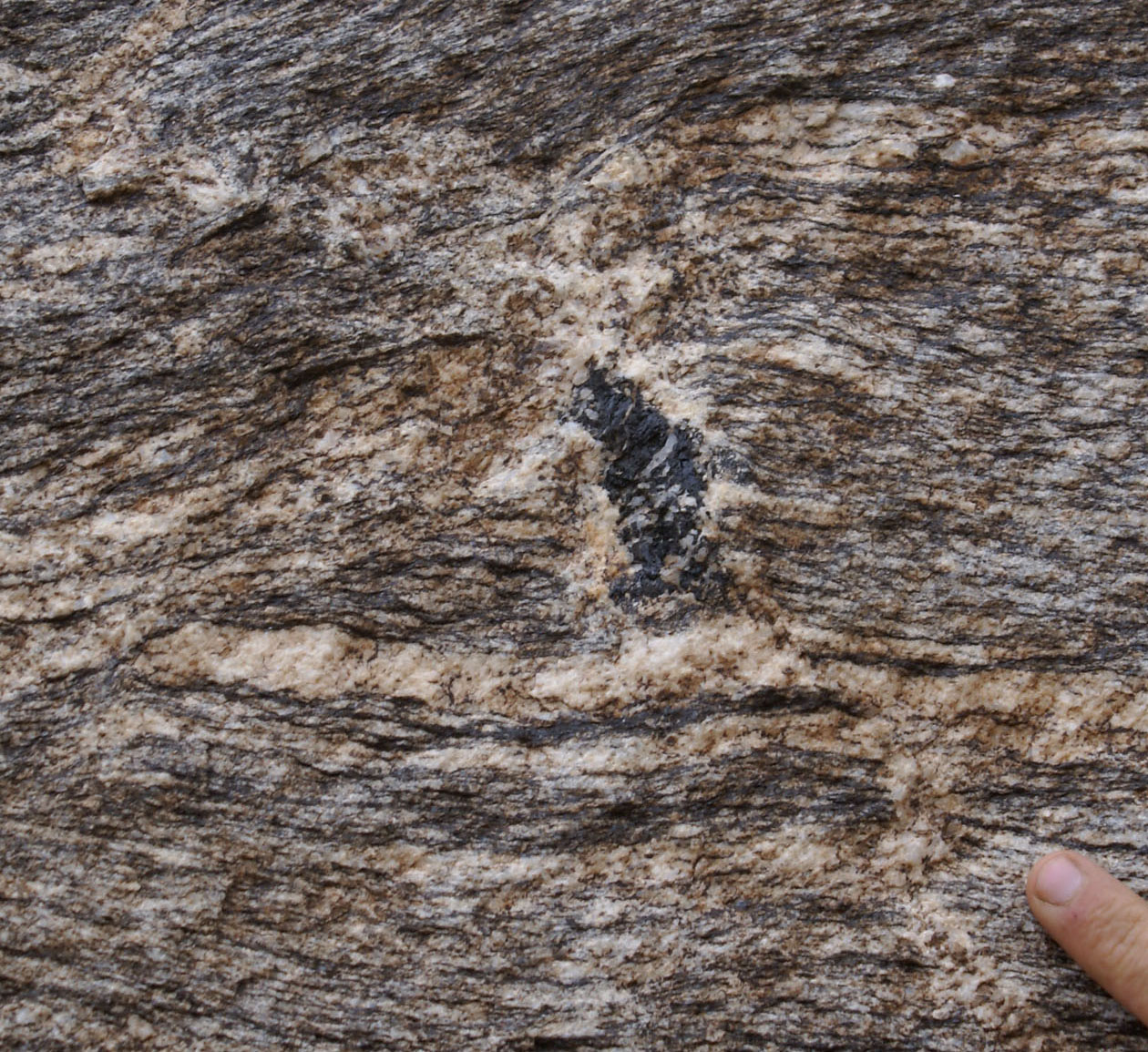
|
| Figure
6a) Garnet and its leucosome crenulated in hinge zone of late folding .
Tml-rich leucosomes are axial planar to this fold and fills in boudins
in limbs (Figures 6c). |
Figure
6b) Tml-leucogranite leucosome with diffuse boundaries with
surroundings (in situ) but also cross-cutting strong foliation and
layering, including layers rich in garnet-sillimanite-biotite and
associated leucosomes, suggesting an earlier partial melting event. |
Figure
6c) Same outcrop as Fig. 6a, showing a leucosome in boudin neck with
large tourmaline grain linked to Ms-bearing leucosome system (parallel
and left of finger, and then parallel to foliation. This represents
melt segregation in the limb of the fold that crenulated
early formed, garnet-bearing leucosomes (Fig. 6a). |
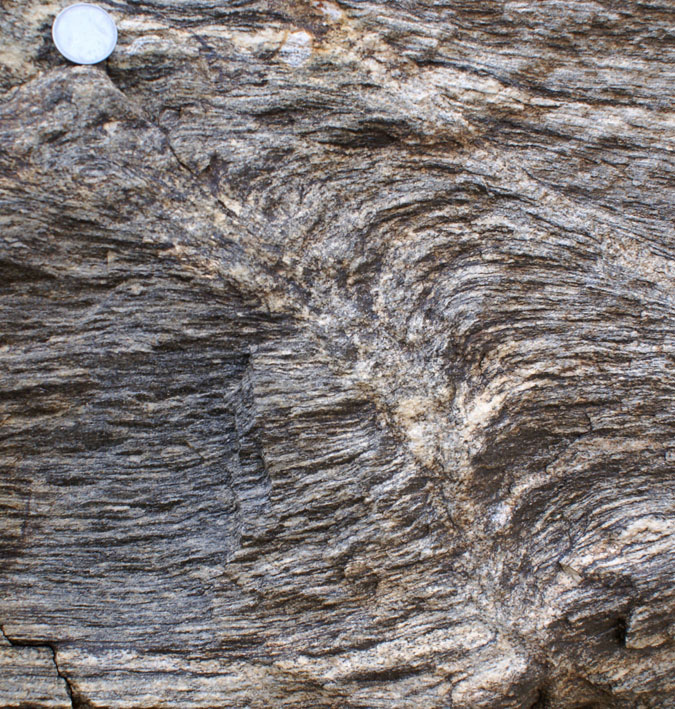
|
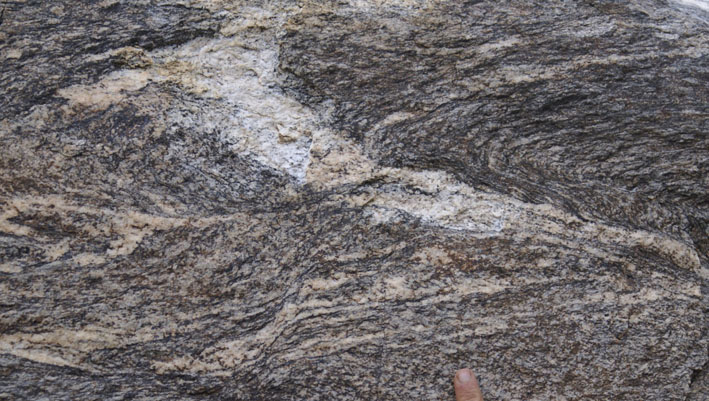
|
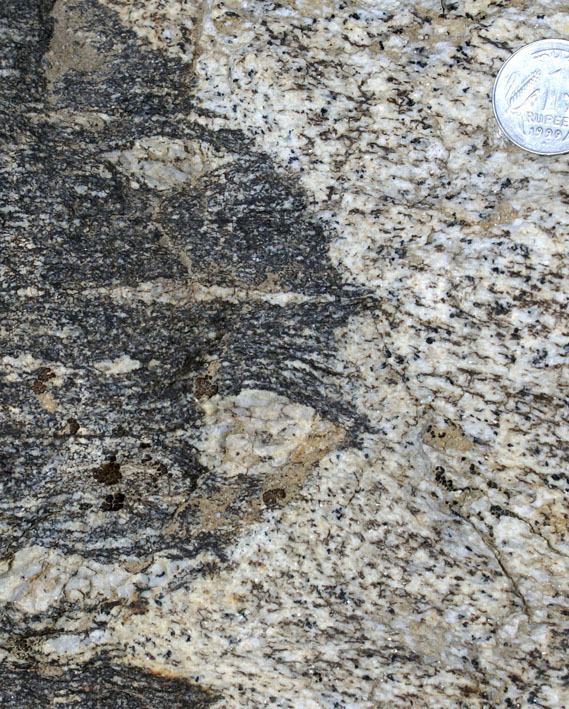
|
| Figure
6d and e) Segregation of Ms-Tml-Bt leucosomes into a thrust plane that
lubricates a fold-thrust. Melt in the thrust plane is linked
continuously with melt in folde leucosomes suggesting in situ
derivation during deformation. This melting event is mineralogically
and temporally distinct to the one producing the garnet-leucosome
association depicted in Fig. 6a. d) Depitcs an early stage of
development of a melt-lubricated fold-thrust, whereas e) depicts a late
stage
characterized by tighter fold and better defined leucosome
seggregation. Same outcrop as Fig. 6a and c. |
Figure
6e) Same as d but a later
stage of evolution of a
melt-lubricated fold-thrust. |
Figure
6f) Migmatitic gneiss
with coarse-grained felsic leucosome
lenses including minor Bt, cut across by a finer-grained Tml-Bt
granite. This granite has interfingering contacts with the migmatite
suggesting local derivation, at least in part. Also the granite has the
same E-W foliation as the gneiss, suggesting that it is contemporaneous
with or older than the deformation event that produced such
foliation. |
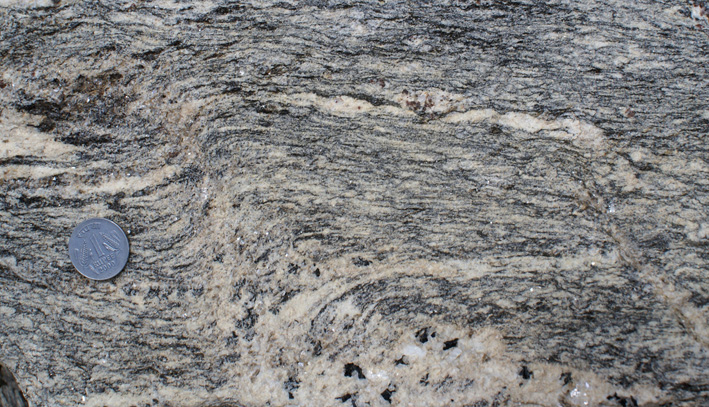
|
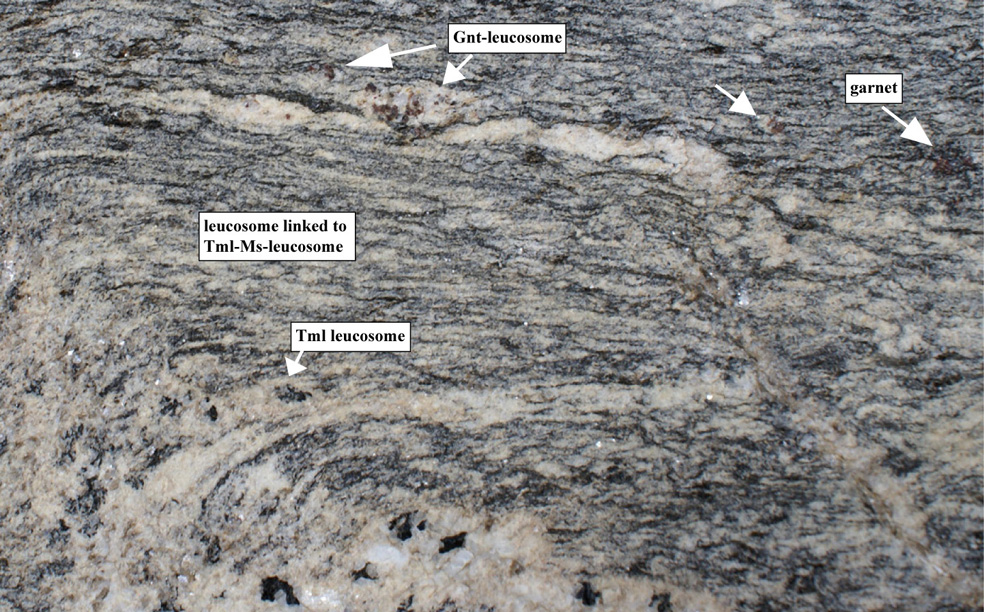
|
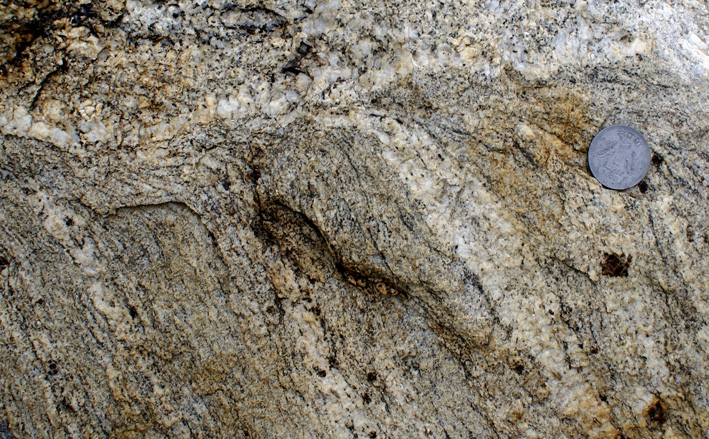
|
| Figure
7a) Segregation of Tml-Ms leucogranite into an incipient fold hing,
from foliation-parallel leucosomes in the granite. Granite has garnet
in small leucosomes not physically linked to the network that feeds
the leucogranite segregation. These are interpreted to represent an
early anatectic phase of Bt-dehydration melting. |
Figure
7b) Detail of a. |
Figure
7c) Similarly to Figure 7a, Tml-Bt-Ms leucogranite dyke linked
continuously a foliation-parallel leucosome lacking garnet, in a rock
with numerous garnets in leucosomes interpreted to pre-date the dyke. |
e) Early Bt-leucomes related to water-fluxed anatexis overprinted by
Tml-Ms-Bt-Gnt (water-fluxed) leucosomes
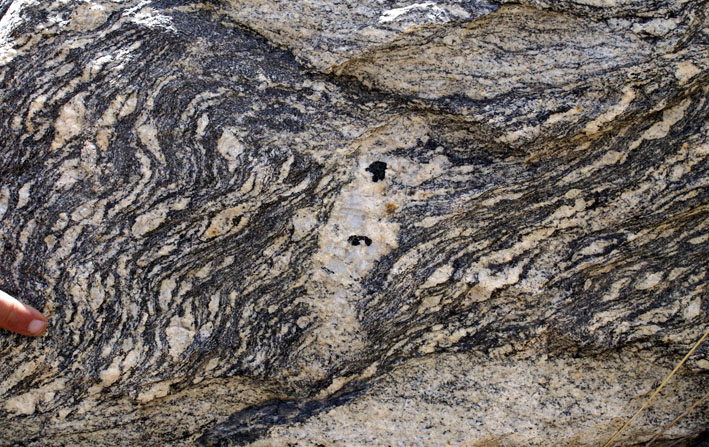
|
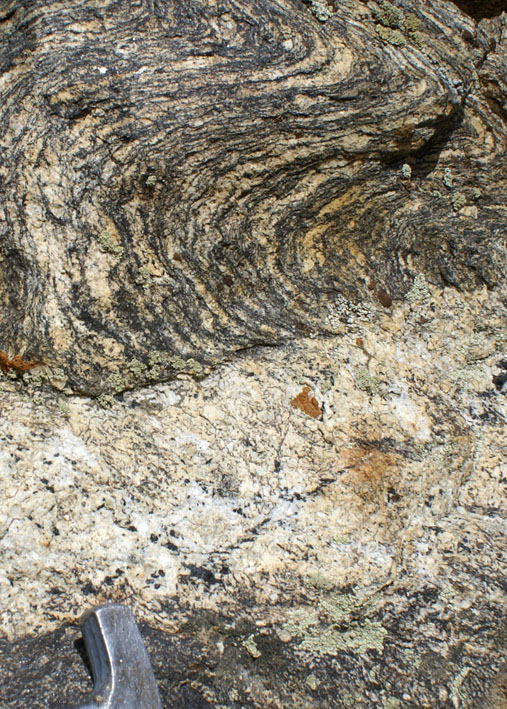
|

|
| Figure
8a) Ms-Bt migmatitic gneiss with lens-shaped leucosomes parallel to a
folded foliation (interpreted to represent the first anatectic event
lacking Tml or peritectic minerals). This is cross-cut by a later phase
of Tml-Bt leucogranite which is linked continuously with a
Bt-leucogranite dykes (horizontal band along the bottom and top of the
photograph). This late phase has diffuse boundaries against the
surrounding migmatite in one part (black arrow), and a cross-cutting
relationship boundary in another (dashed arrow). This relationship can
be interpreted either as a late tectonic Tml-Bt bearing melting event
overprinting a pre-existing, but still unconsolidated early anatectic
event, or a pre-existing, re-solidified migmatite. |
Figure
8b) Folded migmatite cut across by late Tml-leucogranite (~axial planar
to folds). |
Figure
8c) . |
f) Migration of Tml-Ms-Bt-Gnt leucogranite: this section expands on
some of the syn-kinematic extraction features already described above
such as concentration
in boudin necks, shear planes associated with folds, and axial planar
segregations
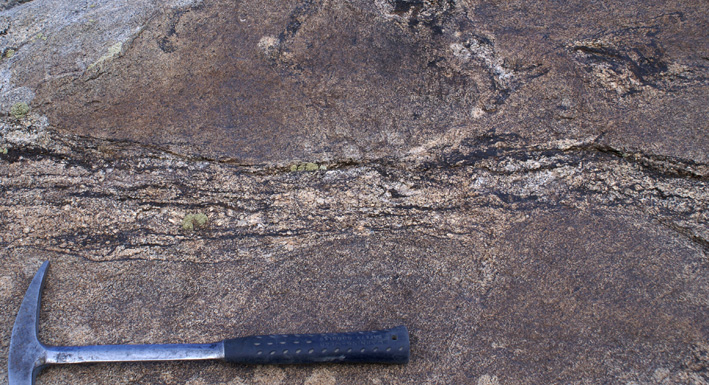
|
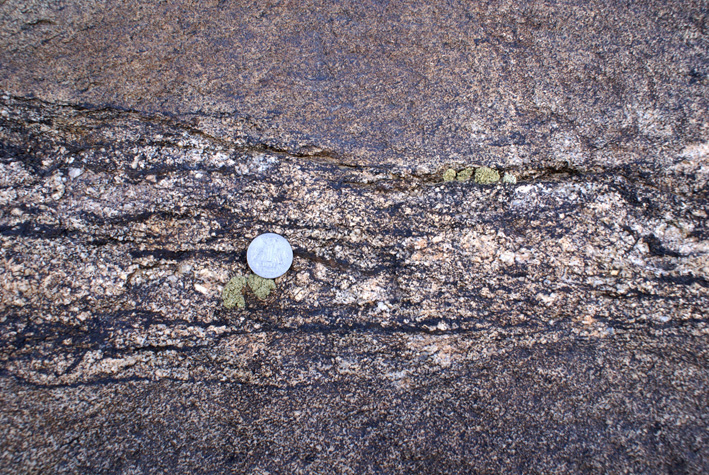
|
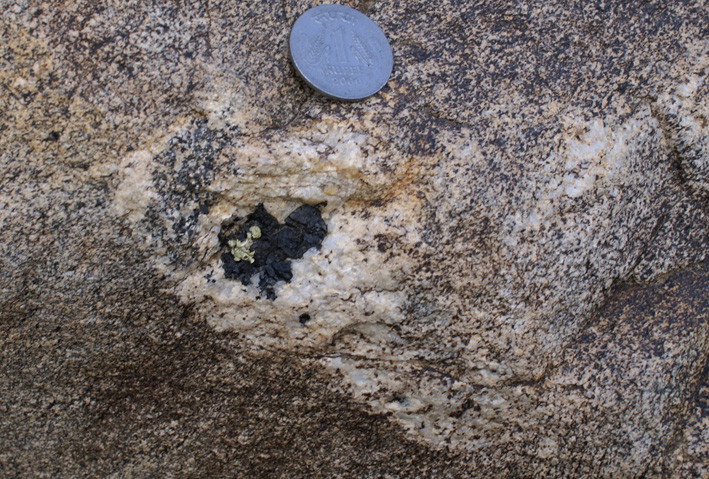
|
| Figure
9a) Layered dyke characterized by melanocratic bands and leucocratic
bands interpreted to represent mobilization of a diatexite. This dyke
was linked in the field with a patch migmatite, such as the one in the
upper right corner of the photograph. Lack of peritectic minerals or
tourmaline or muscovite suggest that this represents the first
water-fluxed anatectic event characterized by accumulation of
refractory Bt and Qtz in melanosomes. |
Figure
9b) Detail of a). |
Figure
9c) In the same block as a) and b) there are local patch leucosome with
large tourmaline grains. The relative timing in relation to the biotite
is undefined in this block. |
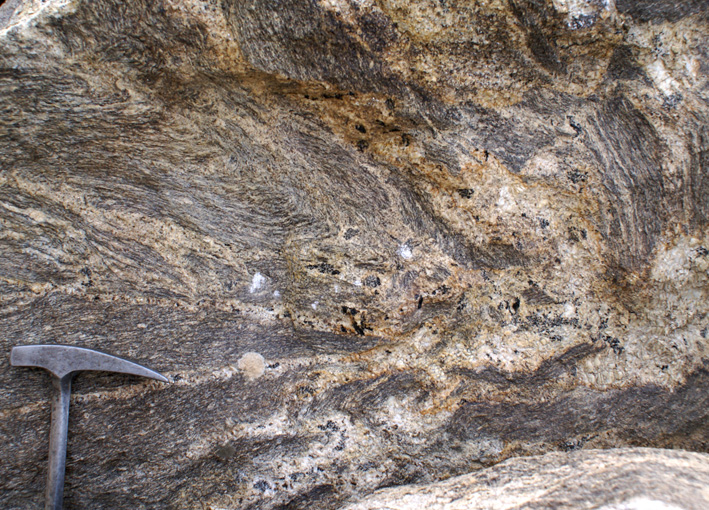
Figure
10) Extraction of Tml-leucosomes through limbs and axial planes from a
folded granitic gneiss. |



